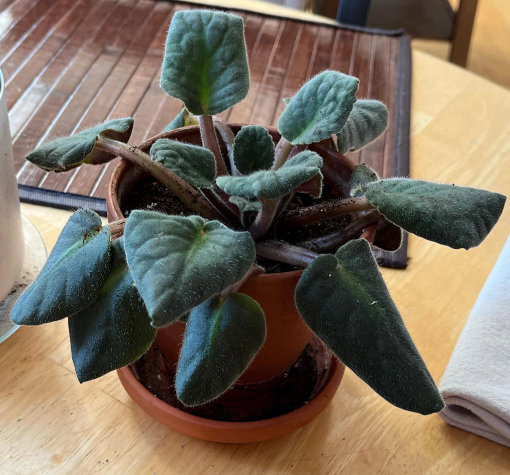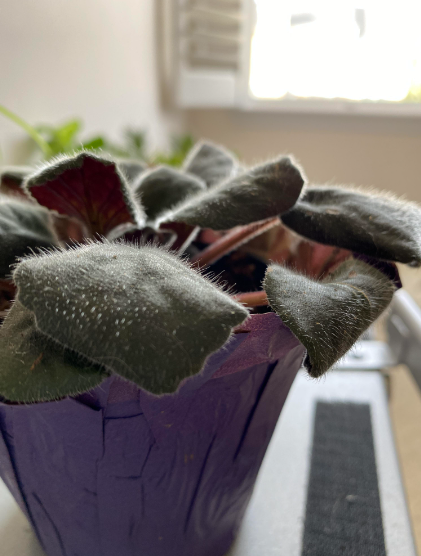African Violets, with their charming, velvety leaves and stunning blossoms, are a favorite among indoor gardeners. These delicate plants, native to Tanzania, captivate with their vibrant hues and compact size, making them perfect for brightening up any corner of your home. Whether you’re a seasoned plant enthusiast or a budding green thumb, cultivating African Violets can be a rewarding and enjoyable experience.
While these beauties are generally low-maintenance, sometimes their leaves exhibit a troubling curl. Understanding and addressing the reasons behind African Violet curled leaves is crucial to maintaining the overall health and vitality of your plants. Curled leaves can be a sign of underlying issues, and by delving into the causes and solutions, you’ll ensure your African Violets not only survive but thrive, gracing your space with their lush foliage and vibrant blooms.
Understanding African Violet Curled Leaves
A. Causes of Curled Leaves in African Violets
- Environmental Factors: African Violets are sensitive to their surroundings. Factors such as sudden temperature changes, drafts, or improper ventilation can lead to leaf curl. Ensuring a stable and suitable environment for your plants is the first step in preventing this issue.
- Nutritional Deficiencies: Just like any other living organism, African Violets need proper nutrition. Curled leaves might indicate deficiencies in essential nutrients like nitrogen, potassium, or magnesium. Regularly feeding your plants with a balanced fertilizer can help address this aspect of their care.
- Pests and Diseases: Unwanted visitors like spider mites or aphids can wreak havoc on your African Violets, causing stress and leaf curl. Regularly inspecting your plants for signs of pests and promptly addressing any issues will keep your violets healthy and their leaves unfurled.

Essential Tips for Healthy Growth
A. Optimal Light Conditions
African Violets thrive in bright, indirect light. Position your plants near a north or east-facing window to provide them with the perfect balance. Avoid exposing them to harsh midday sunlight, as this can lead to leaf burn and curl. If natural light is scarce, consider supplementing with a grow light to ensure your African Violets receive the energy they need for robust growth and uncurled leaves.
B. Proper Watering Techniques
Watering is an art when it comes to African Violets. Overwatering can lead to root rot and, you guessed it, curled leaves. Keep the soil consistently moist but not waterlogged. Water from the bottom to prevent water droplets from settling on the leaves, which can contribute to leaf curl. Invest in a self-watering pot or a wick watering system for a foolproof way to maintain optimal soil moisture.
C. Ideal Soil Composition
African Violets prefer a well-draining, slightly acidic soil mix. A blend of peat moss, perlite, and vermiculite works wonders. Avoid heavy soils that retain too much water, as this can lead to root issues and, subsequently, curled leaves. Repot your African Violets every 6-12 months to refresh the soil and provide them with the nutrients they need for lush, unfurled foliage.
D. Temperature and Humidity Considerations
Maintaining a stable environment is key to preventing African Violet leaf curl. Aim for temperatures between 65-75°F (18-24°C) during the day and a slightly cooler range at night. Consistent humidity levels around 40-60% mimic their natural habitat. Use a humidifier, especially during the dry winter months, to create an environment where your African Violets can thrive without the stress of curled leaves.
Remedies for African Violet Curled Leaves
A. Adjusting Environmental Conditions
- Light Exposure: If your African Violets are experiencing leaf curl, evaluate their light exposure. Ensure they receive enough bright, indirect light, but shield them from harsh, direct sunlight. Consider rotating the pots regularly to promote even growth. If necessary, introduce a sheer curtain to filter sunlight and prevent leaf burn.
- Humidity Control: African Violets thrive in high humidity, but excessive moisture on their leaves can lead to curling. Strike a balance by maintaining a well-ventilated space and using a humidity tray or a humidifier. This will provide the necessary moisture without exposing your violets to the risk of fungal issues and curled leaves.
B. Nutrient Supplementation
- Identifying and Addressing Deficiencies: Conduct regular inspections for signs of nutrient deficiencies. Yellowing or distorted leaves can indicate specific nutrient needs. Adjust your fertilizer regimen to ensure your African Violets receive a balanced blend of essential nutrients. A specially formulated African Violet fertilizer with a balanced N-P-K ratio is ideal for promoting healthy growth and preventing leaf curl.
C. Pest and Disease Management
- Recognizing Common Issues: Stay vigilant against common pests like spider mites, aphids, and mealybugs. Early detection is key to preventing extensive damage. If you notice discolored or misshapen leaves, inspect the plant thoroughly. Isolate affected plants promptly to prevent the spread of pests and diseases.
- Effective Treatment Options: For pest control, consider using insecticidal soap or neem oil, both effective and plant-friendly options. For fungal issues, such as powdery mildew, a gentle fungicide can be applied. Always follow product instructions and avoid overusing chemicals to prevent stressing your African Violets further.

Promoting Vibrant Blooms
A. Fertilization Strategies
African Violets, like any flowering plant, benefit from strategic fertilization. Use a water-soluble, balanced fertilizer with a higher middle number in the N-P-K ratio (such as 12-36-14) to encourage blooming. Apply the fertilizer at half-strength every 2-4 weeks during the growing season. This provides the necessary nutrients to support robust flower production without risking over-fertilization, which could lead to curled leaves.
B. Pruning and Grooming Techniques
Regular pruning is not only about maintaining a tidy appearance but also about promoting healthier growth. Pinch off spent flowers and yellowing or damaged leaves to redirect the plant’s energy into new growth and blossoms. Pruning also helps improve air circulation around the plant, reducing the risk of diseases that can contribute to leaf curl. Use clean, sharp scissors or pruning shears, and remember to remove no more than one-third of the plant at a time to avoid stress.
C. Encouraging Flowering Cycles
African Violets have a natural blooming cycle, and understanding it can enhance the longevity and intensity of their blooms. To encourage continuous flowering, provide consistent care in terms of light, water, and nutrients. Additionally, consider adjusting the day and night temperatures to mimic their native habitat. Cooler nights (around 60°F or 15°C) can stimulate flowering. With the right care, you’ll not only have lush, unfurled leaves but also a constant display of vibrant blossoms.
Conclusion African Violet Curled Leaves
A. Recap of Key Tips for Addressing African Violet Curled Leaves
In conclusion, maintaining the health and beauty of your African Violets involves a combination of understanding their unique needs and promptly addressing any issues that arise. Addressing environmental conditions, providing the right nutrients, and staying vigilant against pests and diseases are crucial steps in preventing and remedying curled leaves. Remember, creating an optimal environment with proper light, watering, soil, and temperature conditions is the foundation for healthy African Violet growth.
B. Encouragement for Achieving Healthy Growth and Vibrant Blooms
As you embark on your journey to cultivate vibrant African Violets, keep in mind that each plant is unique, and adjustments to care may be needed based on individual preferences. Don’t be discouraged by curled leaves – consider it a cue from your plant that it needs a little extra attention. With the right care, your African Violets will reward you with not only unfurled, velvety leaves but also a continuous display of striking blossoms. Embrace the joy of nurturing these charming plants, and soon, you’ll be surrounded by the delightful beauty of healthy African Violets in full bloom.
Happy gardening, and may your African Violets flourish in all their glory! Thank you for visiting Hampton Grows, read our blogpost about leaves problem with topic Avocado Leaves Are Curling? Causes And Easy Fixes.







